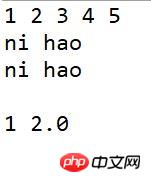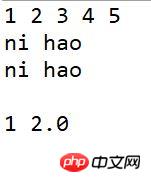Java -- 程式碼詳解可變參數列表
- php是最好的语言原創
- 2018-08-08 11:10:131643瀏覽
如下程式碼,是實現可變參數清單的一種方式。
public static void printAry(Object[] objs){ for(Object obj:objs){
System.out.print(obj+" ");
}
System.out.println();
} public static void main(String[] args) {
printAry(new Object[]{1,2,3,4,5});
printAry(new Object[]{"ni","hao"});
}輸出結果: 
以此方式即可實現向函數傳入任意型別、數量的參數。但是,以上方法是一種比較過時的方法,在Java SE5出來後,提供了更方便的方式。
程式碼如下:
public static void printAry(Object... objs){ for(Object obj:objs){
System.out.print(obj+" ");
}
System.out.println();
} public static void main(String[] args) {
printAry(1,2,3,4,5);
printAry("ni","hao"); //无需显性的创建数组,由编译器自动填充。
printAry(new Object[]{"ni","hao"}); //也可传入数组。
printAry(); //可为空
printAry(new Integer(1),new Float(2));//可传不同类型的参数
}結果: 
#如下程式碼,是實作可變參數清單的一種方式。
public static void printAry(Object[] objs){ for(Object obj:objs){
System.out.print(obj+" ");
}
System.out.println();
} public static void main(String[] args) {
printAry(new Object[]{1,2,3,4,5});
printAry(new Object[]{"ni","hao"});
}輸出結果: 
以此方式即可實現向函數傳入任意型別、數量的參數。但是,以上方法是一種比較過時的方法,在Java SE5出來後,提供了更方便的方式。
程式碼如下:
public static void printAry(Object... objs){ for(Object obj:objs){
System.out.print(obj+" ");
}
System.out.println();
} public static void main(String[] args) {
printAry(1,2,3,4,5);
printAry("ni","hao"); //无需显性的创建数组,由编译器自动填充。
printAry(new Object[]{"ni","hao"}); //也可传入数组。
printAry(); //可为空
printAry(new Integer(1),new Float(2));//可传不同类型的参数
}結果: 
#相關推薦:
以上是Java -- 程式碼詳解可變參數列表的詳細內容。更多資訊請關注PHP中文網其他相關文章!
陳述:
本文內容由網友自願投稿,版權歸原作者所有。本站不承擔相應的法律責任。如發現涉嫌抄襲或侵權的內容,請聯絡admin@php.cn

